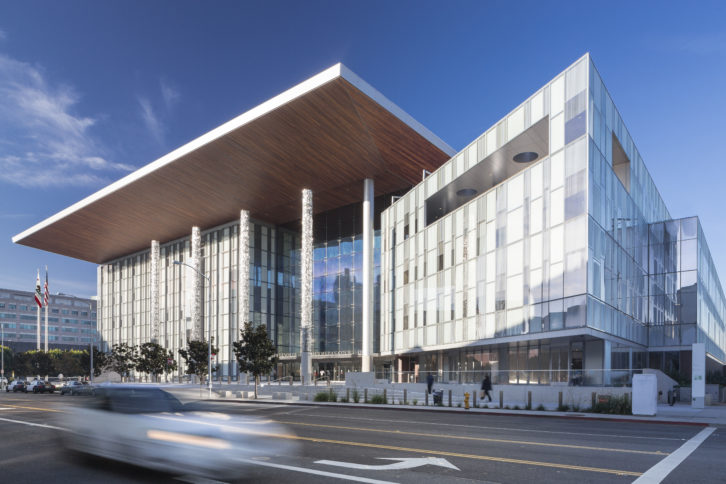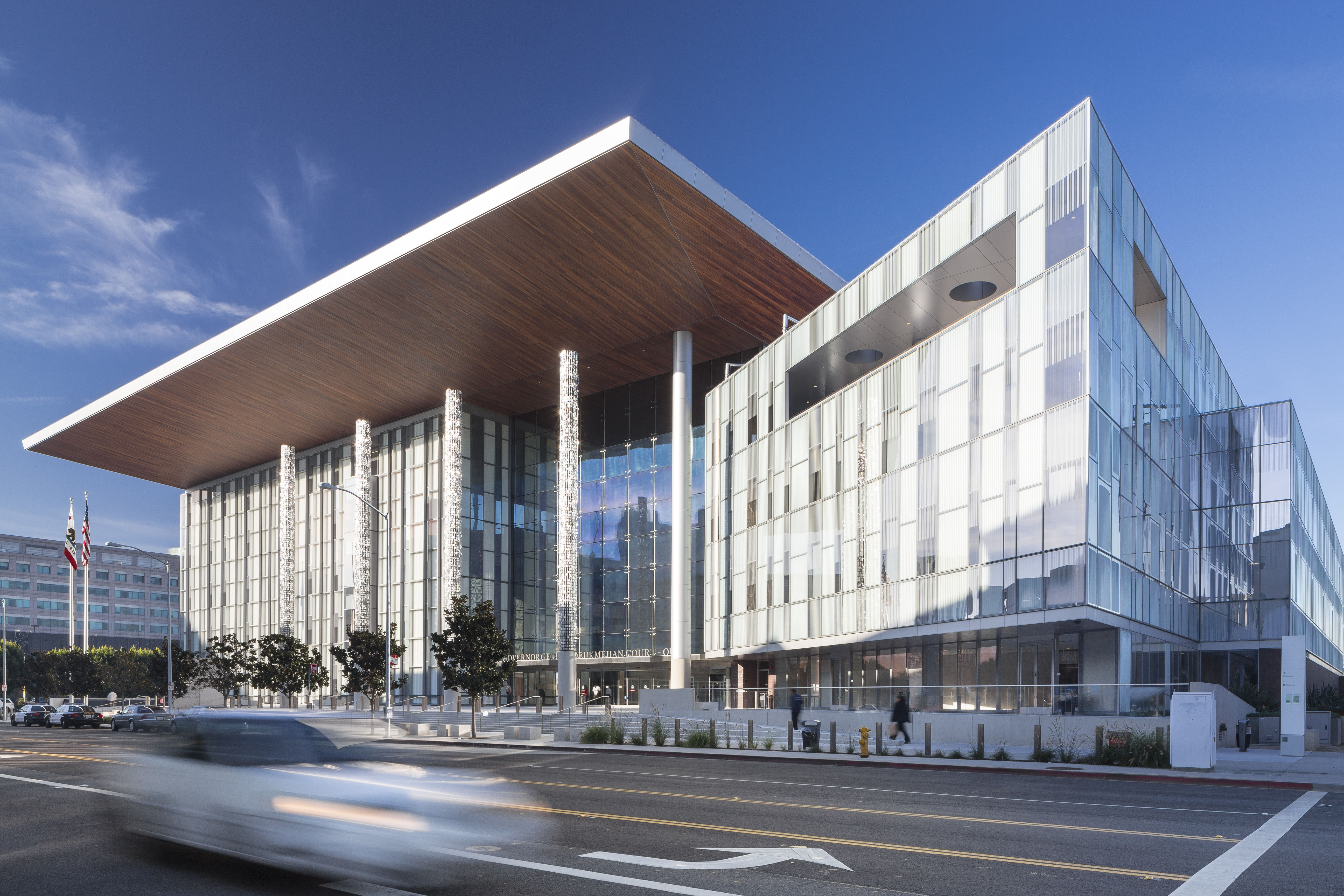

The Governor George Deukmejian Courthouse in Long Beach, Calif., is a pioneering public building and foreshadows how these buildings—and their AV systems—may be designed, built, and maintained in the future.
The Deukmejian Courthouse is the first civic building in the United States to be delivered as a “performance-based availability-payment public private partnership (P3).” These types of partnerships have been underway in Europe for decades—particularly in the UK. For America, they are a new way for government to leverage the expertise of the private sector to finance, design, build, operate, and maintain government buildings and infrastructure, including the AV systems.
In this inaugural project, the developer is Long Beach Judicial Partners (LBJP), a Meridiam Infrastructure Project Company. LBJP put together a consortium of experts from the private sector that included advisors, design, construction, and facility management companies, in response to a competitive RFP process lead by the Judicial Counsel of California (JCC). LBJP was selected as Preferred Bidder, winning the contract award. Once the new courthouse building was accepted and occupied, JCC began making service fee payments to LBJP. Service fee payments are made on a predetermined schedule known to the government entity during procurement; they form the basis of contract execution to include finance, design, construction, operations, and maintenance over a 35-year contract. During those years, LBJP is responsible for managing and maintaining the function of the building, and can be subject to thousands of dollars if the facility does not operate in accordance with JCC standards. That’s called a “performance-based infrastructure (PBI).”
P3/PBI arrangements don’t just help government entities with funding capital investment. They also present unique incentives to ensure that the design, construction, and maintenance of the building is executed to a high and future-proof standard. It also sets up a relationship among the client, developer, builder, architect, and all the construction trades that is more collaborative and accountable. There is private money at stake if the building does not deliver on functionality. Because that functionality, in large part, depends on the initial quality of the building and the interoperability of the systems, you can see how this would clearly impact each aspect of the design/build.
Since it opened last year, the courthouse has won numerous development, design, business, and government awards. As the first P3 project in the United States, and as one of the first courthouses in California with digital AV, it merited a closer look.
As I approached the more than 500,000-square-foot courthouse, which fills two city blocks, I was struck by the architecture; it conveys an unmistakable image of civic pride. The angular, multi-hued glass walls and the warm, Ipe hardwood eaves suggest a concert hall or museum; when the building opened last fall, a Los Angeles Times reporter overhead a young boy asking his father if there would be dinosaurs inside.
As citizens converge upon the courthouse to conduct their business, they pass a group of tall columns clad in aluminum leaves that shimmer like birch trees. As you draw nearer to the wide entrance, glimpses of the building’s dramatic angles reinforce the feeling that this is a civic landmark. However, inside the vast atrium lobby, the vibe changes to all business—more like an airline terminal— sparingly decorated and dominated by the sky that pours in from every direction.
Part of what makes the building seem so public is the combination of imposing architecture and the simplicity of the interior. Inside, there is really just a single flourish: an ethereal LED video sculpture, which—large as it is—seems delicate in the massive space. There is a spacious lineup of no-nonsense metal detector stations and a bank of wayfinding video screens that guide patrons to their courtrooms, as if listing flight arrivals and departures. Ascending the lobby escalators to the 4th of six floors, the angles and structure of the building remain the main aesthetic element—and they are dramatic. But the interior is resolutely low-key, in monochromatic shades of eggshell and grey. It seemed clear that civics was the driving force, not luxury.

The AV system is much the same way— all about function. The elegance lies in the design of the digital network, which provides a building-wide integrated system, supporting 31 courtrooms, a beautifully designed jury assembly room, the judges’ chambers and conference rooms, offices, digital signage, a group of mobile AV carts, and remote digital hookups for broadcast media.
Ironically, this very modern and interconnected AV system was originally envisioned as analog. Instead, over the course of the design/build, it became one of the first all-digital courts in the California system.
But let me back up. It’s important to understand that the previous courthouse was a 1960s interpretation of something from a Charles Dickens novel. You can still see it, standing empty a block from the new building. It was crowded, infested with rats and roaches, not to ADA code, and seismically unsafe. There was almost no AV. However, with budget constraints and so much to be done throughout the California court system, the solutions weren’t so easy; the state needed to new ways to solve old problems.
For the new courthouse, the goal was to make up for 55 years of deferred upgrades and catch up to the most recent standards. For the AV systems, however, that meant adhering to the most recent 2006 California Courts AV standard—an analog standard.
AV consultant Randy Willis, PE, manager of the media systems group at McKay Conant Hoover (MCH), says they based the response to the original RFP and the budget on that 2006 AV standard. “We had to take it into consideration, but it would have been barely possible to have completed the project using it, especially two years down the road. It would have been impractical and a logistical impossibility,” he says. In fact, the courts were already aware that the standard needed to be updated, and the update by the state was already in process.
“We had the ability to see the direction they were heading with the new standards. In some cases we had input,” Willis says. “Even though we were not bound by the developing spec, we made every effort to meet it and actually exceeded it.
Superior Court: Performance-based Infrastructure and Digital AV
Nov 11, 2014 5:32 PM, Cynthia Wisehart
“In truth, the lynchpin was when we decided to go digital, then everything fell into place from there,” Willis says. MCH, ExhibitOne, the technology integrator Johnson Controls, and the design-builder LBJP, and JCC started “long discussions on equipment selection and reliability and how to ensure that court proceedings would never come to a halt because of AV. A lot of the newer digital equipment has significantly better lifespan and remote diagnostics, and network capability,” Willis continues. He says they were also looking to provide a platform that could support future changes. “We’re heading toward, ultimately, everything is going to be on an Ethernet switch. We wanted to build a system that would set them up for those kinds of inevitable changes.”
The public-private partnership between the developer and the state allowed for this kind of flexibility during the design process. “It had to come into our thinking, ‘How do we build a system for a client who was charged with managing the building for 35 years?’” Willis says.
Freddy Rayes is the CEO of LBJP and explained what that means as we were leaving his sparse, windowless office to tour the building. His responsibility is every permanent element in the building. From an AV standpoint this means all cable and terminations, all installed speakers, and the HVAC in the many control rooms. The racks and AV endpoints— things such as videoscreens, lecterns, control panels, the mobile AV carts, the amplifiers, and DSP units—are considered “furnishings” and are not contractually LBJP’s responsibility. The operation, maintenance, and replacement of these furnishings are the responsibility of the Los Angeles Superior Court.
Rayes explains that LBJP’s third-party facility management contractor, Johnson Controls, has the service contract for all the cable and rack room infrastructure (which they pulled and helped build), but the AV system and endpoints (installed by ExhibitOne) belong to the courthouse; it is up to the court to award that service agreement separately and to determine when upgrades should be made.
All this scope is defined contractually—and it has to be or these P3 projects don’t work. However, it seems clear that that cross-discipline collaboration was a key aspect of the life and future of this building.
One of the most obvious examples is in the rack rooms. There are two midsize rack rooms on each floor, which house all the communication, IT, and security electronics—not just the AV. The shared conduit/cable system and HVAC, and the unified rack design, make for one of the cleanest and most elegantly wired rack rooms I’ve seen. All these systems could not have realistically been co-located if the AV was analog.
“Frankly that was contributing factor to the decision to go digital,” Willis says. “Had we stayed analog, we would have had long distances, and we would have needed significantly more conduit, to manage all the signal types. Once we jump on a digital background, we’re on a data transport type of stream, and then you factor the savings in infrastructure and HVAC. Although going digital cost more from a raw looking-at-the-system standpoint, if you look outside that envelope and look at it holistically, it saved money.”
Willis says the move to digital also helped get AV a stronger place at the table. “So often the AV systems are an afterthought or they’re relegated to a lesser position than the data traffic. For us to actually be moving data and being digital put us on the same playing field. We were in the same room. We were no longer the stepchild,” he says.
The AV systems integrator also had an equal place at the table, says Frank Vass CTSD, manager of engineering for ExhibitOne. As a long-time integrator of courtroom systems and an expert in how AV systems must work within the legal system, ExhibitOne was tackling its first digital system and its first in California on this project. Vass says it was both a technical opportunity and a business one; ExhibitOne has subsequently won contracts for nine other California courtrooms.

The most visible AV centerpiece of the Governor George Deukmejian Courthouse is the state-of-the-art jury facility, which resembles a large, multi-room, in-flight lounge. In the areas pictured above, jurors have access to computers, connectivity for their own devices. In the jury assembly room, overhead rows of high-impact displays are used to communicate juror instructions and other information from a touchpanel-driven lectern.
“Digital is easier than analog, but it is less forgiving. You save miles and miles of cable,” Vass says, but, emphasizes the critical importance of quality termination and testing.
Vass recalls the numerous design and coordination meetings to deal with the shift to digital, as well as the emerging compliance standards—such as those for HDCP—that came out during the process. “It’s zeros and ones, and they either talk to each other or they don’t. Coming from the analog world, that might feel like a lack of control. You can’t just solve something by coiling a cable in the bottom of a rack to introduce a delay. But it is that uniformity of the digital world that makes it ultimately easier to use.”
Vass says it also made it easier to give the court the workflow and interconnectivity they needed, with signal able to go anywhere in the building and even out to mobile news trucks with the swipe of a touchscreen. (Vass, Rayes, and Willis all brought up the disruptive image of news crews who used to lug huge bundles of cables up the steps and into the courtrooms.)
The anchor of the AV system was Biamp Tesira. The original design had been based on the well-respected Biamp Audia, which has been a standard in the courtroom. “But when we looked at some of the design criteria, and as the system was being redesigned to the new standards, we realized that Tesira and Tesira Server would be a better fit,” says Brent Stark, southwest regional manager for Biamp. “Randy and ExhibitOne came to the same conclusion.”
Key to their decision, Stark says, was that Tesira is a card-based DSP. The courthouse system runs on CobraNet, “but they can change to Dante, AVB, or ultimately other future protocols with changing the cards.” A good feature when you are looking 35 years into the future.
Vass says Biamp was very supportive with engineering throughout the process and, as Stark says, “an extra pair of eyes. Sometimes when an installer is trying to work out the best ways to do something—for example, how to assign the VLANs—we can take a look and come up with some additions and changes to the programming and to the network set up. You’ve got guys in the field who have been staring at this for 90 days. Good integrators are always attuned to the fact that they need a second set of eyes to give you advice. ‘What do you see? What can be improved upon?’”
“Having a manufacturer who will stick with you is really important,” Vass echoes. “There is a constant process of building digital knowledge and experience. We had to train and educate our people and bring them up to speed on digital, get them certified,” Vass says, “But that’s the cost of doing business now. If you want to stay in the business, you will stay in the forefront—you will make the effort. If you take a complacent stance, go as far as we’re comfortable with and don’t go any further, and wait until things get proven, you’ll get left behind. ”
Likewise, Rayes says the biggest key to the success of the year-old building wasn’t technology but training for the end-users (including the judges themselves). That effort, he says, is how people end up using the systems and being happy with them—and what keeps Rayes phone from ringing.
Ultimately Vass says it was the California court system that blazed the trail. “They made the investment in the 21st century.”
The P3 Players
JCC selected Long Beach Judicial Partners LLC (LBJP), a project company formed by Meridiam, to finance, design, build, operate, and maintain the project. LBJP contracted with Clark Design/Build of California as the project’s design-builder. Clark was assisted on this project by its affiliate, Edgemoor Real Estate Services. Clark in turn contracted with AECOM as the courthouse’s architect-engineer of record. LBJP separately engaged Johnson Controls as its operating service provider. Meridiam raised 100 percent of the financing required to complete the project on behalf of LBJP. Financial advisors included KPMG and BNP Paribas. Fulbright & Jaworski LLP provides legal counsel to Meridiam and LBJP.










